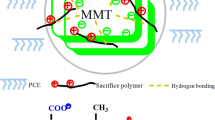Abstract
The adsorption affinity of a surfactant foaming agent (SFA), α-olefin sulphonate (AOS)—used for generation of foam for low density concrete—to organically-modified montmorillonite (OMMT) has been investigated. OMMT has been proposed as an additive to cement and concrete for improved strength and durability. Similar thermodynamic processes are involved in the generation and stabilisation of foam and in the compatibilisation and stabilisation of organic particles in aqueous environments, so interaction between SFA and OMMT particles is likely. Association of foaming agent molecules with organoclay may lead to poor foaming performance and potential instability of the nanoparticles due to displacement of dispersants from the particle surface by foaming agent. Adsorption isotherms determined using a combination of ion-pair reverse phase high performance liquid chromatography (RP-HPLC) and gravimetric methods revealed that there is a relatively high affinity of AOS for the organoclay particles. This is a dynamic process, with smaller molecules adsorbing quickly but being displaced by larger molecules at higher surfactant loading. From the adsorption isotherm it was possible to calculate the minimum AOS addition that will ensure the full foaming performance in the cement formulation. Relative adsorption affinity and competitive adsorption at the particle surface of AOS with non-ionic and anionic surfactants commonly used as wetting and dispersing agents, was studied. The dispersants displayed considerably higher relative adsorption onto the organoclay than AOS, particularly in the case of the anionic species. There is evidence that some AOS adsorption takes place in particle systems stabilised by non-ionic dispersants; displacement of high adsorption affinity dispersants by the lower affinity AOS from the OMMT particle surface was not observed.









Similar content being viewed by others
Abbreviations
- SFA:
-
Surfactant foaming agent
- AOS:
-
α-olefin sulphonate
- OMMT:
-
Organically-modified montmorillonite
- RP-HPLC:
-
Reverse phase high performance liquid chromatography
- HLB:
-
Hydrophilic–lipophilic balance
- MB2HT-MMT:
-
Methylbenzyl di-hydrogenated tallow ammonium chloride modified montmorillonite
- AE:
-
Fatty alcohol polyoxyethylene
- AAS:
-
Anionic alkyl-aryl sulphonate
- UV:
-
Ultraviolet
- MPI:
-
N-methylpyridinium iodide
References
van den Tempel M (1960) The function of stabilizers during emulsification. 3rd Int Congr surf Act, Cologne 2:573
Ramamuthy K, Kunhanandan Nambiar EK, Indu Siva Ranjani G (2009) A classification of studies on properties of foam concrete. Cem Concr Compos 31:388–396
Yakovlev G, Keriene J, Gailius A, Girniene I (2006) Cement based foam concrete reinforced by carbon nanotubes. Medžiagotyra 12:147–151
Kuo W-YK, Huang J-S, Lin C-H (2006) Effects of organo-modified montmorillonite on strengths and permeability of cement mortars. Cem Concr Res 36:886–895
Aly M, Hashmi MJ, Olabi AG, Messeiry M, Hussain AI (2011) Effect of nano clay particles on mechanical, thermal and physical behaviours of waste-glass cement mortars. Mater Sci Eng A 528:7991–7998
Hakamy A, Shaikh FA, Low IM (2014) Characteristics of hemp fabric reinforced nanoclay–cement nanocomposites. Cem Concr Compos 50:27–35
Yeganeh JK, Sadegh M, Kourki H (2008) Recycled HIPS and nanoclay in improvement of cement mortar properties. Malays Polym J 3:38–50
Tadros TF (2005) Adsorption of surfactants and polymeric surfactants at the solid/liquid interface. In: Applied surfactants: principles and applications. Wiley-VCH, Weinheim, pp 85–114
Cohen Stuart MA, Scheutjens JH, Fleer GJ (1980) Polydispersity effects and the interpretation of polymer adsorption isotherms. J Polym Sci 18:559–573
Zahrobsky M, Camporese D, Rist O, Carlsen PHJ (2005) HPLC analysis of aliphatic sulfonate surfactants using ion-pair detection. Molecules 10:1179–1189
Zavoid RM, Knittel JJ (2013) Drug design and relationship of functional groups to pharmologic activity. In: Lemke TL, Villiams DA (eds) Foye’s principles of medicinal chemistry, 7th edn. Wolters Kluwer, Philadelphia, pp 29–60
Kronenberg B, Holmberg K, Lindman B (2014) Surface chemistry of surfactants and polymers. Wiley, Chichester, pp 1–47
Acknowledgments
The author would like to acknowledge the European Commission funding under the 7th Framework Programme for the project FIBCEM—Nanotechnology Enhanced Extruded Fibre Reinforced Cement Based Environmentally Friendly Sandwich Material for Building Applications (Grant agreement no. 262954). Thanks to project partners Laviosa Chimica Mineraria and to the Lithuanian Energy Institute for powder supply and characterisation, and Sika SAU for foaming agent supply. Thanks also to Croda Chemicals Europe for supply of surfactants.
Author information
Authors and Affiliations
Corresponding author
Rights and permissions
About this article
Cite this article
Naden, B.J. Competitive adsorption of surfactant foaming agents to nanoclays added to cement foams for enhanced strength. Mater Struct 49, 1667–1675 (2016). https://doi.org/10.1617/s11527-015-0603-9
Received:
Accepted:
Published:
Issue Date:
DOI: https://doi.org/10.1617/s11527-015-0603-9




